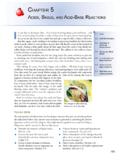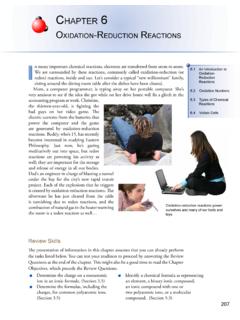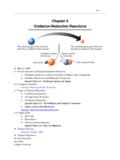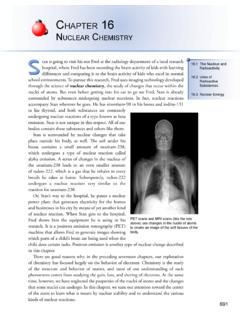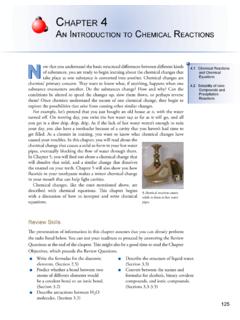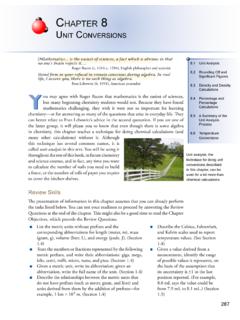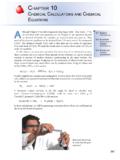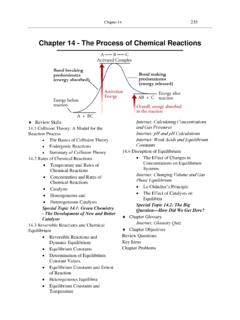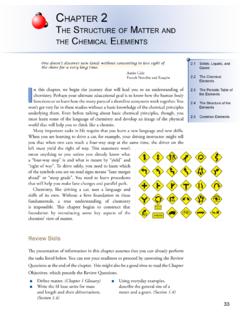Transcription of Chapter 1 An Introduction to Chemistry
1 1 Chapter 1 An Introduction to Chemistry What Is Chemistry , and What Can Chemistry Do for You? Special Topic : Green Chemistry Suggestions for Studying Chemistry The Scientific Method Measurement and Units The International System of Measurement Special Topic : Wanted: A New Kilogram SI Units Derived from Standards SI Units Derived from Metric Prefixes More About Length Units More About Volume Units Mass and Weight Temperature Reporting Values from Measurements Accuracy and Precision Describing Measurements Digital Readouts Chapter Glossary Internet.
2 Glossary Quiz Chapter Objectives Key Ideas Chapter Problems 2 Study Guide for An Introduction to Chemistry section Goals and Introductions section What Is Chemistry , and What Can Chemistry Do for You? Goal: To explain a bit about what Chemistry is and why it s important. This section shows you some of the questions that an understanding of Chemistry helps to answer and some of the issues of concern to chemists. Throughout the text, you will see Special Topics, such as Special Topic : Green Chemistry , that will reinforce the attitude that Chemistry is an important science that expands our understanding of the world around us and helps us to change that world, often in ways that are beneficial to us and to our environment.
3 This section ends with a commercial message: you cannot get the benefits that an understanding of Chemistry brings without first concentrating on the basics, which are not always very interesting and which do not always seem directly related to the real world. Trust me. If you master the basics, you will be explaining the way the physical world works to your friends and family in no time. section Suggestions for Studying Chemistry Goals To suggest some study strategies. To introduce you to some of the unique components of the text.
4 It s very important that you understand from the beginning of the course that learning Chemistry is a time-consuming task that is best approached in a logical and efficient way. So one goal of this section is to make some suggestions to you about how you might study most efficiently. Another goal is to be sure that you know the tools that you have available to help you. Be sure you know where to find and how to use each of the following: Review Skills, Examples, Exercises, Internet tools, Glossary, Objectives, and End-of- Chapter Problems.
5 I want to stress the importance of one of these somewhat unique components, the Objectives. An attempt has been made to write an objective for every skill that you should learn from the text. If you can meet the objectives, you will ace the exams. Be sure to ask your instructor about changes to the list. It s difficult to use someone else s objectives, so your instructor is likely to add objectives and eliminate some of those found in the text. section The Scientific Method Goal: To give you an idea of how science is done.
6 This section describes one way that science is done and shows how this method was applied in the development of an understanding of Parkinson s disease and in the development of treatments for it. section Measurement and Units Goal: To introduce units of measurement. In this section , you will learn that a value contains a number and a unit, and you will learn a lot about the units used in the International System of Measurement (SI). When you are done studying this section , be sure that you know the common SI units used to describe length, volume, mass, and temperature.
7 It is important that you be able to write the relationship Chapter 1 An Introduction to Chemistry 3 between metric units derived from the metric prefixes and the base unit for that same type of measurement. (See Example ) This section also shows you the relative sizes of English and metric units and explains the difference between mass and weight (two terms that are often confused). section Reporting Values from Measurements Goal: To show how scientists report values from measurements. This section is especially important for students who are taking a course with a laboratory section included.
8 It describes some of the factors that a scientist considers when deciding how to report values derived from measurements. Chapter Map (Sections and ) Chapter Checklist Read the Chapter quickly before the lecture that describes it. Attend class meetings, take notes, and participate in class discussions. Work the Chapter Exercises, perhaps using the Chapter Examples as guides. Study the Chapter Glossary and test yourself on our Web site: Internet: Glossary Quiz Study all of the Chapter Objectives.
9 You might want to write a description of how you will meet each objective. (Although it is best to master all of the objectives, the following objectives are especially important because they pertain to skills that you will need while studying other chapters of this text: 3, 4, 5, 6, 7, 10, 11, 14, and 19.) 4 Study Guide for An Introduction to Chemistry Memorize the following. (Be sure to check with your instructor to determine how much you are expected to know of the following.) SI base units (Table ) The table below contains the four base units that you should know now.
10 Type of Measurement Base Unit Abbreviation Length meter m mass kilogram kg time second s temperature kelvin K Metric prefixes (Table ) The table below contains the most common of these prefixes. Prefixes for large units Prefixes for small units Prefix Abbreviation Value Prefix Abbreviation Value giga G 1,000,000,000 or 109 centi c or 10 2 mega M 1,000.
